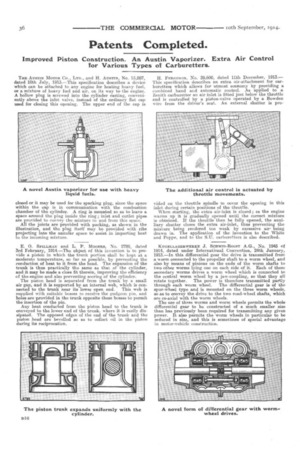Patents Completed.
Page 18

If you've noticed an error in this article please click here to report it so we can fix it.
Improved Piston Construction. An Austin Vaporizer. Extra Air Control for Various Types of Carburetters.
THE AUSTIN MOTOR Co., LTD., and H. Ausrtu, No. 15,887, dated 10th July, 1913.—This specification describes a device which can be attached to any engine for heating heavy fuel, or a mixture of heavy fuel and air, on its way to the engine. A hollow plug is screwed into the cylinder casting, conveniently above the inlet valve, instead of the ordinary flat cap used for closing this opening. The upper end of the cap is
closed or it may be used for the sparking plug, since the space within the cap is in communication with the combustion chamber of the cylinder. A ring is mounted so as to leave a space around the plug inside the ring ; inlet and outlet pipes are provided to convey the mixture to and from this space.
All the joints are provided with peeking, as shown in the illustrationi and the plug itself may be provided with ribs projecting into the annular space to assist in imparting heat to the incoming mixture.
R O. SPILLMAN and L. P. Moocas, No. 2789, dated 3rd February, 1914.—Th0 object of this invention is to provide a piston in which the trunk portion shall be kept at a moderate temperature, so far as possible, by preventing the conduction of heat to it from the head. The expansion of the trunk is thus practically the same as that of the cylinder, and it may be made a close fit therein, improving the efficiency of the engine and also preventing scoring of the cylinder.
The piston head is separated from the trunk by a small air gap, and it is supported by an internal web, which is connected to the trunk near its lower open end. This web is supplied with suitable bosses to receive the gudgeon pin, and holes are provided in the trunk opposite these bosses to permit the insertion of the pin.
Any heat conducted from the piston head to the trunk is conveyed to the lower end of the trunk, where it is easily dissipated. The opposed edges of the end of the trunk and the piston head are bevelled SD as to collect oil in the piston during its reciprocation.
H. FRIRG 'IRON, No. 28,600, dated 11th December, 1913.— This specification describes an extra air-attachment for carburetters which allows for utmost economy by providing a combined hand and automatic control. As applied to a Zenith carburetter an air inlet is fitted just below the throttle and is controlled by a piston-valve operated by a Bowden wire from the driver's seat. An external shutter is pro
vided on the throttle spindle to cover the opening in this inlet during certain positions of the throttle. When starting, the extra air-inlet is closed ; as the engine warms up it is gradually opened until the correct mixture is obtained. If the throttle then be fully opened, the auxiliary shutter closes the extra air-inlet, thus preventing the mixture being rendered too weak by excessive air being drawn in. The application of the invention to the White and Poppe, and to the S.U. carburetters is also described.
GELLAGERWERKE J. Scamp-Ryon A.G., No. 1945 of 1914, dated under International Convention, 24th January, 1913.—In this differential gear the drive is transmitted from a worm connected to the propeller shaft to a worm wheel, and also by means of pinions on the ends of the worm shafts to two other worms lying one on each side of it. Each of these secondary worms drives a worm wheel which is connected to the central worm wheel by a jaw-coupling, so that they all rotate together. The power is therefore transmitted partly through each worm wheel. The differential gear is of the spur-wheel type and is mounted on the three worm wheels, so as to convey the drive to the two road-wheel shafts, which are co-axial with the worm wheels.
The Use Of three worms and worm wheels permits the whole differential gear to be constructed of a much smaller size than has previously been required for transmitting any given power. It also permits the worm wheels in particular to be reduced in size, and this is sometimes of special advantage in motor-vehicle construction.


















